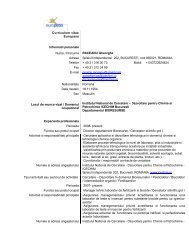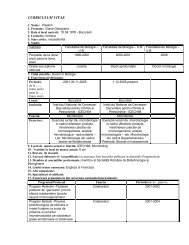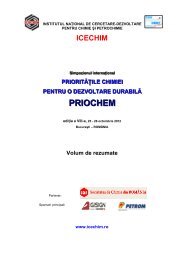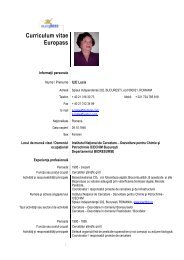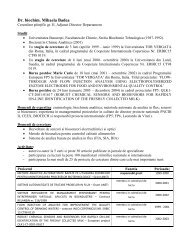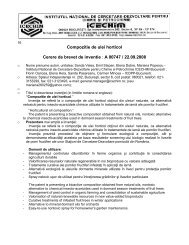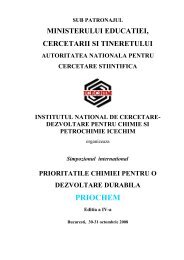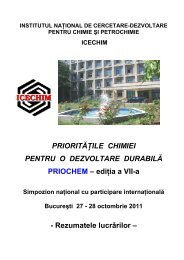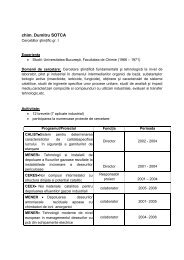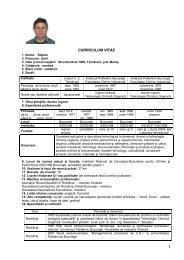POE - INDUSTRIA PETROCHIMICA DIN ROMANIA – - ICECHIM
POE - INDUSTRIA PETROCHIMICA DIN ROMANIA – - ICECHIM
POE - INDUSTRIA PETROCHIMICA DIN ROMANIA – - ICECHIM
You also want an ePaper? Increase the reach of your titles
YUMPU automatically turns print PDFs into web optimized ePapers that Google loves.
COMPARISON BETWEEN MOLECULARLY IMPRINTED POLYMERS PREPARATION<br />
BY PHASE INVERSION AND RADICAL POLYMERISATION<br />
Stefan-Ovidiu Dima1<br />
, Andrei Sarbu1 , Tanase Dobre2 , Tanta-Verona Nicolescu1 , Marius<br />
Ghiurea 1 , Anita-Laura Radu 1 , Anamaria Lungu 1<br />
1 National Institute of Research and Development in Chemistry and Petrochemistry <strong>ICECHIM</strong>, 202<br />
Splaiul Independentei, 6 th District, C.P. 15-159, postal code 06002,1 Bucharest, Romania,<br />
E-mail: phd.ovidiu.dima@gmail.com<br />
2 Polytechnic University of Bucharest, 313 Splaiul Independentei, postal code 060042, Bucharest,<br />
Romania<br />
Since the beginning of polymer imprentation, in 1972 by Wulf and Sarhan 1 , this method has<br />
gain interest in the high selective material domain preparation for separation purposes. A molecularly<br />
imprinted polymer is a polymer that formed in the presence of a molecule that is extracted afterwards,<br />
thus leaving complementary molecular cavities behind with specific electronic surroundings. The<br />
affinity for the target molecule suggests that they can be used in applications of advanced separations,<br />
biosensors, the mechanism being similar to antibodies and enzymes.<br />
Whatever the final form of the polymer, particles, membranes 2 or gels, obtaining selective<br />
materials 3 can be made using two methods: phase inversion and polymerisation by auto-assembly. The<br />
functional mechanism of these MIP’s is similar to antibodies and enzymes. Phase inversion method<br />
involves precipitation of the polymer in a suitable solution containing the template molecule. Auto-<br />
assembly method consists in pre-mixing the template and the monomer to establish specific physical<br />
bonding and then, by adding a hardening agent, the structure template-monomer is "frozen" by<br />
polymerization.<br />
References:<br />
[1]. G. Wulff and A. Sarhan, Angew.Chem., 1972, 84, 364.<br />
[2] Parkt, J.K., Seo, J.II, Characteristics of Phenylalanine Imprinted Membrane Prepared by the Wet Phase Inversion<br />
Method, Korean J. Chem. Eng.,2002, 19(6),940-948.<br />
[3] Silvestri, D., Coluccio, M.L. , Barbani, N., Ciardelli, G., Cristallini, C., Pegoraro, C., Giusti, P., Poly(ethylene-co-vinyl<br />
alcohol) membranes with specific adsorption properties for potential clinical application, Desalination 199, 2006, 138<strong>–</strong>140.<br />
Comunicare orala<br />
27




